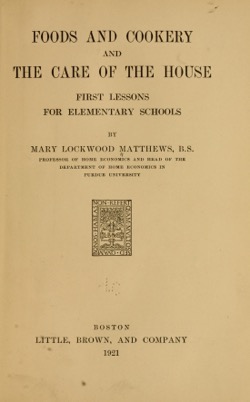Archive.org has a host of old cookery books (from mid-19th to mid-20th Century) available in many formats and on a host of topics. I happened across a few in my Pinterest feed and gone completely down the rabbit hole in this treasure trove of information. Sure some ideas might be out of date, but you never know what you might find when you explore these books. I’ll be sharing more books as I find them in the coming weeks. –Douglas
PREFACE
This volume is intended for use in classes begin- ning the study of foods and cookery. It has been arranged for use in the elementary schools and does not presuppose any training in general science. It is strictly an elementary treatment of the subject.
The book deals with foods, their selection and preparation, and the planning of meals from the nutritive, aesthetic and economic standpoints. The “meal plan” is used in order to make the meal the basis of the work. Through the “Home Problems” the home and school work may be correlated.
The author appreciates the help given in illus- trating the book by the United States Department of Agriculture, the United States Bureau of Stand- ards, the Detroit Stove Works, and the Chambers Manufacturing Company. The author also grate- fully acknowledges the criticisms and suggestions of educators who kindly read the manuscript.
TO THE STUDENT
Have you thought about what you will do when you finish school ?
Perhaps you have decided to be a teacher, a librarian, a stenographer, a doctor, a nurse. Perhaps you are making plans to take a course in high school or college that will fit you for one of these callings ; you would not consider yourself capable of entering any of them without training.
Very probably you will be at some time the manager of a home. Have you thought about the importance of being trained for home-making?
It is only within the past twenty-five years that it has been considered proper for the public schools to train girls for the work which most of them will do for the longest period in their lives, the work of home-making.
Mrs. Ellen H. Richards was the first to say that the schools ought to teach ” right living;” and, largely through her efforts and her inspiration, plans have been worked out whereby girls while in school can be taught many things about right living.
Right living begins with the home. Who makes the home? The man may furnish the money to build and maintain the house, but it is the woman who plans and manages the home. It is her busi- ness to see that the family lives in a sanitary and an attractive house ; that every member of the family has clean, properly selected and well cooked food ; that every one is suitably clothed ; that the family income is wisely spent, and that all in the home are helped to lead a happy and useful life.
No girl should consider the making and managing of a home an easy piece of work, for in fact nothing is harder to do and to do well.
When the girl takes work in school and college that covers all phases of home-making, we say that she is taking a course in Home Economics.
THE DINING ROOM
The dining room should be a light, cheerful room, situated so that the sunlight reaches it at some time every day, preferably in the morning. This room should be large enough to permit easy passing behind the chairs when persons are seated around the table.
The walls should be finished in light colors rather than dark, which tend to make the room appear gloomy. The window curtains should be of a kind easily laundered, since draperies in a dining room are apt to hold dirt and odors and need frequent cleaning.
The floor is best made of hard wood, as a rug may then be used instead of a carpet. A dining-room floor would be more sanitary if no covering were used, but the noise made by using a bare floor is annoying to many persons.
The furniture should be plain in design. Wood or cane-seated chairs are perhaps better to use than upholstered, because they are easier to keep clean. A dining-table with a top having a waxed finish is much better than one highly varnished. • The top of the sideboard and serving-table should not be crowded with dishes of various kinds. A dining room is more pleasing with few pictures, or none at all, and with little bric-a-brac or few dishes used as decoration.
When buying a “set” of dishes it is best to select a style with simple decoration or without decoration. Large conspicuous designs and bright colors become tiresome when the dishes are used often. A good quality of china with no decoration is a wise choice for a “set “, because any type of decorated dish looks well with it.
Silver knives and forks should be of the same pattern, but the spoons may be of different design. Silver never looks well unless it is kept polished.
White linen tablecloths and napkins are better to buy than cotton, because linen wears longer and launders much better than cotton. Luncheon sets of various types may be used instead of a tablecloth, and are much easier to launder
Available in PDF, Text, JPG formats, and more
Learn more about cooking history with these books
* A portion of each sale from Amazon.com directly supports our blogs
** Many of these books may be available from your local library. Check it out!
† Available from the LA Public Library






